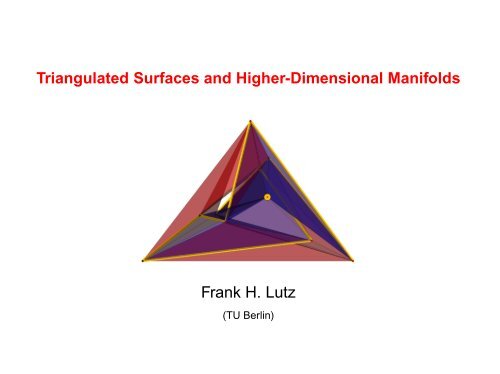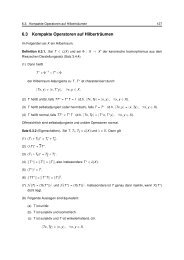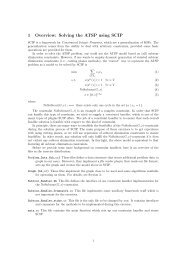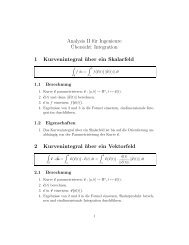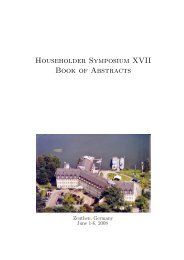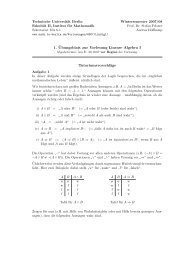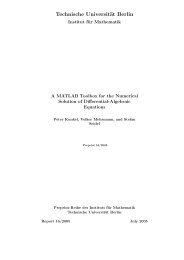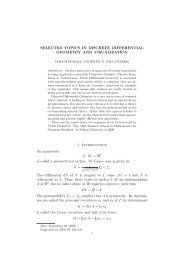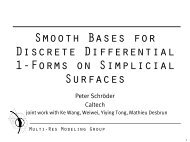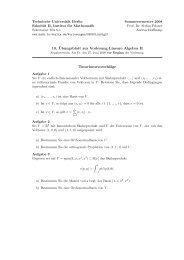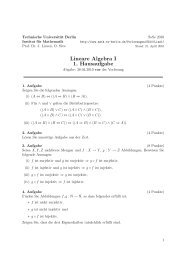Triangulated Surfaces and Higher-Dimensional Manifolds - TU Berlin
Triangulated Surfaces and Higher-Dimensional Manifolds - TU Berlin
Triangulated Surfaces and Higher-Dimensional Manifolds - TU Berlin
You also want an ePaper? Increase the reach of your titles
YUMPU automatically turns print PDFs into web optimized ePapers that Google loves.
<strong>Triangulated</strong> <strong>Surfaces</strong> <strong>and</strong> <strong>Higher</strong>-<strong>Dimensional</strong> <strong>Manifolds</strong><br />
Frank H. Lutz<br />
(<strong>TU</strong> <strong>Berlin</strong>)
----------------------------------------------<br />
Topology: orientable, genus g = 3<br />
Combinatorics:<br />
Geometry:<br />
vertex-minimal, n = 10 vertices,<br />
irreducible<br />
coordinate-minimal,<br />
general position
Combinatorics:<br />
triangulated<br />
2-manifold M :<br />
f-vector f = (n, f 1 , f 2 ).<br />
double counting 3f 2 = 2f 1<br />
Euler characteristic χ(M) = n − f 1 + f 2<br />
=⇒ f = (n, 3n − 3χ(M), 2n − 2χ(M))<br />
----------------------------------------------
----------------------------------------------<br />
Combinatorics:<br />
triangulated<br />
2-manifold M :<br />
f-vector f = (n, f 1 , f 2 ).<br />
double counting 3f 2 = 2f 1<br />
Euler characteristic χ(M) = n − f 1 + f 2<br />
=⇒ f = (n, 3n − 3χ(M), 2n − 2χ(M))<br />
number of edges: f 1 ≤ ( )<br />
n<br />
2<br />
i.e. n 2 − 7n + 6χ(M) ≥ 0
----------------------------------------------<br />
PROPOSITION HEAWOOD (1890)<br />
n ≥<br />
⌈<br />
1<br />
2 (7 + √ 49 − 24χ(M))⌉
----------------------------------------------<br />
PROPOSITION HEAWOOD (1890)<br />
n ≥<br />
⌈<br />
1<br />
2 (7 + √ 49 − 24χ(M))⌉<br />
THEOREM RINGEL (1955)/JUNGERMAN & RINGEL (1980)<br />
For every surface M, with the exception of<br />
M(2, +), M(2, −), <strong>and</strong> M(3, −),<br />
there is a triangulation with n vertices<br />
iff<br />
⌈<br />
n ≥ 1<br />
2 (7 + √ 49 − 24χ(M))⌉<br />
.<br />
(In the exceptional cases one vertex has to be added.)
----------------------------------------------<br />
Examples:<br />
χ(S 2 ) = 2: n ≥ 4<br />
χ(RP 2 ) = 1: n ≥ 6<br />
χ(T 2 ) = 0: n ≥ 7<br />
1<br />
1<br />
7 3 4 7<br />
3 4<br />
2<br />
1<br />
6<br />
1<br />
2<br />
4<br />
3<br />
5<br />
2 1<br />
3<br />
6<br />
2 5 2<br />
7 3<br />
4<br />
7
----------------------------------------------<br />
Enumeration/Realization:<br />
7 3 4 7<br />
[ 1, 2, 3 ], [ 1, 2, 4 ],<br />
[ 1, 3, 7 ], [ 1, 4, 5 ],<br />
[ 1, 5, 6 ], [ 1, 6, 7 ],<br />
[ 2, 3, 6 ], [ 2, 4, 7 ],<br />
[ 2, 5, 6 ], [ 2, 5, 7 ],<br />
[ 3, 4, 5 ], [ 3, 4, 6 ],<br />
[ 3, 5, 7 ], [ 4, 6, 7 ]<br />
1<br />
1<br />
6<br />
2 5 2<br />
7 3<br />
4<br />
7<br />
Möbius’ torus (1861)
----------------------------------------------<br />
Enumeration/Realization:<br />
7<br />
Coordinates:<br />
[ 1, 2, 3 ], [ 1, 2, 4 ],<br />
[ 1, 3, 7 ], [ 1, 4, 5 ],<br />
[ 1, 5, 6 ], [ 1, 6, 7 ],<br />
[ 2, 3, 6 ], [ 2, 4, 7 ],<br />
[ 2, 5, 6 ], [ 2, 5, 7 ],<br />
[ 3, 4, 5 ], [ 3, 4, 6 ],<br />
[ 3, 5, 7 ], [ 4, 6, 7 ]<br />
1: (3,-3,0)<br />
2: (-3,3,0)<br />
3: (-3,-3,1)<br />
4: (3,3,1)<br />
5: (-1,-2,3)<br />
6: (1,2,3)<br />
7: (0,0,15)<br />
5<br />
6<br />
1<br />
3<br />
4<br />
2<br />
Császár’s torus (1949)
----------------------------------------------<br />
Enumeration schemes:<br />
1. Generation from irreducible triangulations.<br />
2. Lexicographic enumeration.<br />
3. Strongly connected enumeration.
----------------------------------------------<br />
Enumeration schemes:<br />
1. Generation from irreducible triangulations.<br />
2. Lexicographic enumeration.<br />
3. Strongly connected enumeration.
[Royle, 2001]: n Types<br />
4 1<br />
5 1<br />
6 2<br />
7 5<br />
8 14<br />
9 50<br />
10 233<br />
11 1.249<br />
12 7.595<br />
13 49.566<br />
14 339.722<br />
15 2.406.841<br />
16 17.490.241<br />
17 129.664.753<br />
18 977.526.957<br />
19 7.475.907.149<br />
20 57.896.349.553<br />
21 453.382.272.049<br />
22 3.585.853.662.949<br />
23 28.615.703.421.545<br />
<strong>Triangulated</strong><br />
2-spheres<br />
with<br />
4 ≤ n ≤ 23<br />
vertices<br />
----------------------------------------------
----------------------------------------------<br />
edge contraction ↔ vertex split<br />
A triangulation is irreducible if there is no contractible edge.
----------------------------------------------<br />
THEOREM BARNETTE & EDELSON (1989)<br />
All 2-manifolds have finitely many<br />
irreducible triangulations.
----------------------------------------------<br />
THEOREM BARNETTE & EDELSON (1989)<br />
All 2-manifolds have finitely many<br />
irreducible triangulations.<br />
THEOREM NAKAMOTO & OTA (1995)<br />
Irreducible triangulations of a closed surface of genus g<br />
have at most O(g) vertices.
----------------------------------------------<br />
Numbers of irreducible triangulations:<br />
2-sphere: 1 [Steinitz, 1922]<br />
2-torus: 21 [Grünbaum, 1970, Lavrenchenko, 1984]<br />
M(2, +): 396.784 [Sulanke, 2005]<br />
M(3, +): ?<br />
RP 2 2 [Barnette, 1982]<br />
Klein bottle: 29 [Sulanke, 2004]<br />
M(3, −): 9.708 [Sulanke, 2005]<br />
M(4, −): 6.297.982 [Sulanke, 2005]<br />
M(5, −): ?
----------------------------------------------<br />
Enumeration schemes:<br />
1. Generation from irreducible triangulations.<br />
2. Lexicographic enumeration.<br />
3. Strongly connected enumeration.
----------------------------------------------<br />
Basic property:<br />
I :<br />
Every edge lies in exactly two triangles.
----------------------------------------------<br />
Ex.: n = 5 triangle-edge incidence matrix<br />
123<br />
124<br />
125<br />
134<br />
135<br />
145<br />
234<br />
235<br />
245<br />
345<br />
⎛<br />
⎜<br />
⎝<br />
12 13 14 15 23 24 25 34 35 45<br />
1 1 1<br />
1 1 1<br />
1 1 1<br />
1 1 1<br />
1 1 1<br />
1 1 1<br />
1 1 1<br />
1 1 1<br />
1 1 1<br />
1 1 1<br />
⎞<br />
⎟<br />
⎠
Ex.: n = 5 triangle-edge incidence matrix<br />
123<br />
124<br />
125<br />
134<br />
135<br />
145<br />
234<br />
235<br />
245<br />
345<br />
⎛<br />
⎜<br />
⎝<br />
12 13 14 15 23 24 25 34 35 45<br />
1 1 1<br />
1 1 1<br />
1 1 1<br />
1 1 1<br />
1 1 1<br />
1 1 1<br />
1 1 1<br />
1 1 1<br />
1 1 1<br />
1 1 1<br />
2 2 2 0 2 2 2 2 2 2<br />
⎞<br />
⎟<br />
⎠<br />
----------------------------------------------
----------------------------------------------<br />
Ex.: n = 5<br />
123<br />
124<br />
125<br />
134<br />
135<br />
145<br />
234<br />
235<br />
245<br />
345<br />
⎛<br />
⎜<br />
⎝<br />
12 13 14 15 23 24 25 34 35 45<br />
1 1 1<br />
1 1 1<br />
1 1 1<br />
1 1 1<br />
1 1 1<br />
1 1 1<br />
1 1 1<br />
1 1 1<br />
1 1 1<br />
1 1 1<br />
⎞<br />
⎟<br />
⎠
Ex.: n = 5 backtracking!<br />
123<br />
124<br />
125<br />
134<br />
135<br />
145<br />
234<br />
235<br />
245<br />
345<br />
⎛<br />
⎜<br />
⎝<br />
12 13 14 15 23 24 25 34 35 45<br />
1 1 1<br />
1 1 1<br />
1 1 1<br />
1 1 1<br />
1 1 1<br />
1 1 1<br />
1 1 1<br />
1 1 1<br />
1 1 1<br />
1 1 1<br />
⎞<br />
⎟<br />
⎠<br />
1 1 0 0 1 0 0 0 0 0<br />
----------------------------------------------
Ex.: n = 5 backtracking!<br />
123<br />
124<br />
125<br />
134<br />
135<br />
145<br />
234<br />
235<br />
245<br />
345<br />
⎛<br />
⎜<br />
⎝<br />
12 13 14 15 23 24 25 34 35 45<br />
1 1 1<br />
1 1 1<br />
1 1 1<br />
1 1 1<br />
1 1 1<br />
1 1 1<br />
1 1 1<br />
1 1 1<br />
1 1 1<br />
1 1 1<br />
⎞<br />
⎟<br />
⎠<br />
2 1 1 0 1 1 0 0 0 0<br />
----------------------------------------------
Ex.: n = 5 backtracking!<br />
123<br />
124<br />
125<br />
134<br />
135<br />
145<br />
234<br />
235<br />
245<br />
345<br />
⎛<br />
⎜<br />
⎝<br />
12 13 14 15 23 24 25 34 35 45<br />
1 1 1<br />
1 1 1<br />
1 1 1<br />
1 1 1<br />
1 1 1<br />
1 1 1<br />
1 1 1<br />
1 1 1<br />
1 1 1<br />
1 1 1<br />
⎞<br />
⎟<br />
⎠<br />
3 1 1 1 1 1 1 0 0 0<br />
----------------------------------------------
Ex.: n = 5 backtracking!<br />
123<br />
124<br />
125<br />
134<br />
135<br />
145<br />
234<br />
235<br />
245<br />
345<br />
⎛<br />
⎜<br />
⎝<br />
12 13 14 15 23 24 25 34 35 45<br />
1 1 1<br />
1 1 1<br />
1 1 1<br />
1 1 1<br />
1 1 1<br />
1 1 1<br />
1 1 1<br />
1 1 1<br />
1 1 1<br />
1 1 1<br />
⎞<br />
⎟<br />
⎠<br />
2 2 2 0 1 1 0 1 0 0<br />
----------------------------------------------
Ex.: n = 5 backtracking!<br />
123<br />
124<br />
125<br />
134<br />
135<br />
145<br />
234<br />
235<br />
245<br />
345<br />
⎛<br />
⎜<br />
⎝<br />
12 13 14 15 23 24 25 34 35 45<br />
1 1 1<br />
1 1 1<br />
1 1 1<br />
1 1 1<br />
1 1 1<br />
1 1 1<br />
1 1 1<br />
1 1 1<br />
1 1 1<br />
1 1 1<br />
⎞<br />
⎟<br />
⎠<br />
lexicographic<br />
enumeration!<br />
2 2 2 0 1 1 0 1 0 0<br />
----------------------------------------------
Pseudomanifold with isolated singularities:<br />
----------------------------------------------
Pseudomanifold with isolated singularities:<br />
----------------------------------------------
----------------------------------------------<br />
Pseudomanifold with isolated singularities:<br />
II :<br />
The link of a vertex should be one circle.
Several components:<br />
----------------------------------------------
----------------------------------------------<br />
Several components:<br />
III :<br />
The surface should be connected.
----------------------------------------------<br />
<strong>Triangulated</strong> surfaces with up to 10 vertices [L. 2003]:<br />
n Surface Types n Surface Types n Surface Types<br />
4 S 2 1 8 S 2 14 10 S 2 233<br />
T 2 7 T 2 2109<br />
5 S 2 1 M(2, +) 865<br />
RP 2 16 M(3, +) 20<br />
6 S 2 2 K 2 6<br />
RP 2 1210<br />
RP 2 1 9 S 2 50 K 2 4462<br />
T 2 112 M(3, −) 11784<br />
7 S 2 5 M(4, −) 13657<br />
T 2 1 RP 2 134 M(5, −) 7050<br />
K 2 187 M(6, −) 1022<br />
RP 2 3 M(3, −) 133 M(7, −) 14<br />
M(4, −) 37<br />
M(5, −) 2
----------------------------------------------<br />
Isomorphism free lexicographic enumeration:<br />
<strong>Triangulated</strong> surfaces with 11 <strong>and</strong> 12 vertices<br />
[Sulanke & L., 2006].
Realization:<br />
THEOREM STEINITZ (1922)<br />
Every triangulated 2-sphere is realizable<br />
as the boundary of a simplicial 3-polytope.<br />
CONJEC<strong>TU</strong>RE DUKE/GRÜNBAUM (1970/1973)<br />
Every triangulated 2-torus is realizable in R 3 .<br />
THEOREM BOKOWSKI & GUEDES DE OLIVEIRA (2000)<br />
There is a non-realizable 12-vertex triangulation<br />
of the orientable surface of genus 6.<br />
----------------------------------------------
Realization:<br />
THEOREM STEINITZ (1922)<br />
Every triangulated 2-sphere is realizable<br />
as the boundary of a simplicial 3-polytope.<br />
CONJEC<strong>TU</strong>RE DUKE/GRÜNBAUM (1970/1973)<br />
Every triangulated 2-torus is realizable in R 3 .<br />
THEOREM SCHEWE (2006)<br />
For every surface of genus g ≥ 5<br />
there is a non-realizable triangulation.<br />
----------------------------------------------
----------------------------------------------<br />
Realization of vertex-minimal triangulations:<br />
g n min Types Realizable?<br />
0 4 1 yes<br />
1 7 1 yes [Császár, 1949]<br />
2 10 865 [L., 2003] yes [Bokowski & L., 2005]<br />
3 10 20 [L., 2003] yes [Hougardy, L., Zelke, 2006]<br />
4 11 821 [L., 2005] yes [Hougardy, L., Zelke, 2006]<br />
5 12 751.593 [Sulanke, 2005] yes/no [Hougardy, L., Zelke, 2006],<br />
[Schewe, 2006]<br />
6 12 59 [Bokowski, 1996] no [Bokowski & Guedes de Oliveira,<br />
2000], [Schewe, 2006]
Realization heuristics:<br />
----------------------------------------------
----------------------------------------------<br />
Realization heuristics:<br />
r<strong>and</strong>om realization <strong>and</strong> recycling of coordinates: 864 L. (2005)<br />
32768 3
----------------------------------------------<br />
Realization heuristics:<br />
r<strong>and</strong>om realization <strong>and</strong> recycling of coordinates: 864 L. (2005)<br />
32768 3<br />
geometric intuition: 1 Bokowski (2005)
small coordinates: Hougardy, L., Zelke (2005)<br />
----------------------------------------------
----------------------------------------------<br />
THEOREM HOUGARDY, L., ZELKE (2005)<br />
All 865 triangulations of the orientable surface<br />
of genus 2 with 10 vertices are realizable in the (4 ×4×4)-cube.
----------------------------------------------<br />
THEOREM HOUGARDY, L., ZELKE (2006)<br />
At least 17 of the 20 triangulations of the orientable surface<br />
of genus 3 with 10 vertices are realizable in the (5 ×5×5)-cube.
----------------------------------------------<br />
THEOREM HOUGARDY, L., ZELKE (2006)<br />
At least 17 of the 20 triangulations of the orientable surface<br />
of genus 3 with 10 vertices are realizable in the (5 ×5×5)-cube.<br />
THEOREM HOUGARDY, L., ZELKE (2005)<br />
All 20 triangulations of the orientable surface<br />
of genus 3 with 10 vertices are realizable.
----------------------------------------------<br />
intersection edge functional: Hougardy, L., Zelke (2005)<br />
E<br />
f<br />
a<br />
c<br />
u<br />
w<br />
b<br />
v<br />
d<br />
e
Example:<br />
----------------------------------------------
----------------------------------------------<br />
g = 4, n = 11:<br />
All 821 examples are realizable [HLZ, 2006].<br />
g = 5, n = 12:<br />
At least 15 of the 751.593 examples are realizable [HLZ, 2006]<br />
<strong>and</strong> at least 3 are not realizable [Schewe, 2006].
g = 4, n = 11:<br />
All 821 examples are realizable [HLZ, 2006].<br />
g = 5, n = 12:<br />
At least 15 of the 751.593 examples are realizable [HLZ, 2006]<br />
<strong>and</strong> at least 3 are not realizable [Schewe, 2006].<br />
CONJEC<strong>TU</strong>RE<br />
Every triangulated surface of genus 1 ≤ g ≤ 4<br />
is realizable in R 3 .<br />
----------------------------------------------
----------------------------------------------<br />
Enumeration schemes:<br />
1. Generation from irreducible triangulations.<br />
2. Lexicographic enumeration.<br />
3. Strongly connected enumeration.
----------------------------------------------<br />
Date: Thu, 3 Feb 2005 17:23:30 +0100<br />
From: John M Sullivan <br />
Subject: triangulations with low edge degree<br />
Dear Frank,<br />
...<br />
Consider triangulated 3-manifolds with every<br />
edge valence at most 5.<br />
Are there really (as I suspect) only a finite number<br />
of such triangulations, <strong>and</strong> are the manifolds then<br />
all spherical?<br />
?<br />
Do you perhaps already have such a list?<br />
If not, can we modify your programs to produce one?<br />
Best, John
----------------------------------------------<br />
Date: Thu, 3 Feb 2005 17:23:30 +0100<br />
From: John M Sullivan <br />
Subject: triangulations with low edge degree<br />
Dear Frank,<br />
...<br />
Consider triangulated 3-manifolds with every<br />
edge valence at most 5.<br />
Are there really (as I suspect) only a finite number<br />
of such triangulations, <strong>and</strong> are the manifolds then<br />
all spherical?<br />
Do you perhaps already have such a list?<br />
If not, can we modify your programs to produce one?<br />
?<br />
No :-(<br />
Best, John
----------------------------------------------<br />
Date: Thu, 3 Feb 2005 17:23:30 +0100<br />
From: John M Sullivan <br />
Subject: triangulations with low edge degree<br />
Dear Frank,<br />
...<br />
Consider triangulated 3-manifolds with every<br />
edge valence at most 5.<br />
Are there really (as I suspect) only a finite number<br />
of such triangulations, <strong>and</strong> are the manifolds then<br />
all spherical?<br />
Do you perhaps already have such a list?<br />
If not, can we modify your programs to produce one?<br />
Best, John<br />
?<br />
No :-(<br />
Yes :-)
Vertex-links: 2-spheres with face vector f = (n, f 1 , f 2 ).<br />
----------------------------------------------
----------------------------------------------<br />
Vertex-links: 2-spheres with face vector f = (n, f 1 , f 2 ).<br />
By Euler’s equation n − f 1 + f 2 = 2<br />
<strong>and</strong> double counting 2f 1 = 3f 2<br />
=⇒ f = (n, 3n − 6, 2n − 4)
----------------------------------------------<br />
Vertex-links: 2-spheres with face vector f = (n, f 1 , f 2 ).<br />
By Euler’s equation n − f 1 + f 2 = 2<br />
<strong>and</strong> double counting 2f 1 = 3f 2<br />
=⇒ f = (n, 3n − 6, 2n − 4)<br />
Vertex-degree ≤ 5: 2f 1 = ∑ deg ≤ 5n.<br />
Thus n ≤ 12
Enumeration (of vertex-links):<br />
----------------------------------------------
Enumeration (of vertex-links):<br />
----------------------------------------------
Enumeration (of vertex-links):<br />
----------------------------------------------
Enumeration (of vertex-links):<br />
----------------------------------------------
----------------------------------------------<br />
Enumeration (of vertex-links):<br />
. . . . . .
----------------------------------------------<br />
Enumeration (of vertex-links):<br />
. . . . . .
----------------------------------------------<br />
Enumeration (of vertex-links):<br />
. . . . . .<br />
. . . . . .
----------------------------------------------<br />
Enumeration (of vertex-links):<br />
. . . . . .<br />
. . . . . .
----------------------------------------------<br />
Enumeration (of vertex-links):<br />
. . . . . .<br />
. . . . . .
----------------------------------------------<br />
Enumeration (of vertex-links):<br />
. . . . . .<br />
strongly connected!<br />
. . . . . .
Vertex-links:<br />
----------------------------------------------
----------------------------------------------<br />
Combinatorial types of 3-manifolds with edge valence at most 5:<br />
n Types n Types n Types n Types n Types<br />
5 1 19 230 33 115 47 15 62 2<br />
6 2 20 275 34 93 48 10 63 2<br />
7 5 21 240 35 76 49 15 64 3<br />
8 7 22 240 36 72 50 6 65 7<br />
9 16 23 214 37 55 51 9 69 1<br />
10 29 24 250 38 46 52 8 72 1<br />
11 37 25 220 39 37 53 11 73 1<br />
12 61 26 205 40 44 54 18 76 4<br />
13 77 27 191 41 54 55 2 80 2<br />
14 111 28 194 42 45 56 4 87 1<br />
15 134 29 174 43 33 57 3 98 1<br />
16 184 30 156 44 17 58 5 120 1<br />
17 202 31 115 45 23 60 3<br />
18 233 32 122 46 16 61 1
----------------------------------------------<br />
THEOREM L. & SULLIVAN (2005)<br />
There are exactly 4787 combinatorially distinct<br />
triangulated 3-manifolds with edge valence at most five:<br />
4761 × S 3 ,<br />
22 × RP 3 ,<br />
2 × L(3, 1),<br />
1 × L(4, 1),<br />
1 × S 3 /Q.<br />
THEOREM MATVEEV & SHEVCHISHIN (2005)<br />
Let M be a triangulated 3-manifold such that every<br />
edge has valence at most five.<br />
Then M is spherical <strong>and</strong> has at most 600 tetrahedra.
----------------------------------------------<br />
THEOREM L. & SULLIVAN (2006)<br />
There are exactly 41 distinct 3-dimensional combinatorial<br />
pseudomanifolds with edge valence at most five.<br />
They all are of type<br />
susp(RP 2 ).
----------------------------------------------<br />
THEOREM L. & SULLIVAN (2006)<br />
There are exactly 41 distinct 3-dimensional combinatorial<br />
pseudomanifolds with edge valence at most five.<br />
They all are of type<br />
susp(RP 2 ).<br />
THEOREM L. & SULLIVAN (2005)<br />
Let M be a triangulated d-manifold such that every<br />
codimension-two face has valence at most four.<br />
Then M is the join product of boundaries of simplices.
----------------------------------------------<br />
Recognition:<br />
Algorithms for the recognition of the 3-sphere:<br />
[Rubinstein, 1992], [Thompson, 1994], [S. Matveev, 1995], . . .
----------------------------------------------<br />
Recognition:<br />
Algorithms for the recognition of the 3-sphere:<br />
[Rubinstein, 1992], [Thompson, 1994], [S. Matveev, 1995], . . .<br />
. . . are exponential, difficult to implement.
----------------------------------------------<br />
Recognition:<br />
Algorithms for the recognition of the 3-sphere:<br />
[Rubinstein, 1992], [Thompson, 1994], [S. Matveev, 1995], . . .<br />
. . . are exponential, difficult to implement.<br />
Heuristics for the recognition of the 3-sphere:<br />
[Björner & L., 1997]<br />
. . . simulated annealing with bistellar flips.
----------------------------------------------<br />
Bistellar Flips/Pachner moves!<br />
2d:<br />
3d:
----------------------------------------------<br />
THEOREM CSORBA & L. (2005)<br />
Hom(C 6 , K 5 ) ∼ = (S 2 × S 2 ) #29 .<br />
f = (1920, 30780, 104520, 126000,50400)<br />
=⇒ f = (33, 379, 1786, 2300, 920)<br />
THEOREM CSORBA & L. (2005)<br />
Hom(C 5 , K 5 ) ∼ = V 4,2<br />
∼ = S 2 × S 3 .<br />
f = (1020, 25770, 143900, 307950,283200,94400)<br />
=⇒ f = (12, 66, 220, 390, 336, 112)
BUT. . .<br />
. . . there is a 3-sphere with no flips (16 vertices)<br />
[Dougherty, Faber, <strong>and</strong> Murphy, 2004]<br />
. . . there are non-shellable/non-constructible 3-spheres<br />
with n ≥ 13 vertices [L., 2004]<br />
. . . there are worse examples [King, 2004]<br />
. . . there is no algorithm to recognize 4-manifolds [Markov, 1958]<br />
. . . there is no algorithm to recognize d-spheres for d ≥ 5<br />
[Novikov, 1962]<br />
. . . there are non-PL spheres [Edwards, 1975], [Cannon, 1979]<br />
. . . there are non-PL d-spheres with d + 13 vertices for d ≥ 5<br />
[Björner & L., 2000]<br />
----------------------------------------------
----------------------------------------------<br />
THEOREM KING (2004)<br />
From any triangulation of S 3 , one can obtain<br />
an edge contractible triangulation of S 3<br />
by a sequence of at most 2 401f2 3<br />
successive expansions.
----------------------------------------------<br />
THEOREM KING (2004)<br />
From any triangulation of S 3 , one can obtain<br />
an edge contractible triangulation of S 3<br />
by a sequence of at most 2 401f2 3<br />
successive expansions.<br />
THEOREM LICKORISH (1991), ZIEGLER (1996), KING (2004)<br />
Every 3-manifold has infinitely many<br />
irreducible triangulations.
Why don’t we run into bad examples?<br />
----------------------------------------------
----------------------------------------------<br />
Why don’t we run into bad examples?<br />
Where do we get our examples from?
----------------------------------------------<br />
Why don’t we run into bad examples?<br />
Where do we get our examples from?<br />
1. Enumeration: bad examples need more space.<br />
2. Combinatorial constructions: mostly harmless.<br />
3. Topological constructions: we usually know the outcome in advance.
Construction of a non-realizable 3-ball with 16 vertices:<br />
----------------------------------------------
----------------------------------------------<br />
Construction of a non-realizable 3-ball with 16 vertices:<br />
15<br />
1<br />
3<br />
7<br />
12<br />
13<br />
10<br />
4 6<br />
5<br />
9<br />
8<br />
11<br />
14<br />
2<br />
non-realizable [non-constructible/non-shellable] 3-ball: (16, 75, 106, 46)<br />
[non-constructible/non-shellable 3-sphere: (17, 91, 148, 74)]
----------------------------------------------<br />
Construction of a non-realizable 3-ball with 12 vertices:<br />
1<br />
3<br />
10<br />
7<br />
4 6<br />
5<br />
8<br />
11<br />
12<br />
9<br />
2<br />
non-realizable [non-constructible/non-shellable] 3-ball: (12, 58, 84, 37)<br />
[non-constructible/non-shellable 3-sphere: (13, 69, 112, 56)]
----------------------------------------------<br />
COROLLARY L. (2003)<br />
There are non-realizable [non-constructible]<br />
d-balls with d + 9 vertices <strong>and</strong> 37 facets for d ≥ 3.
----------------------------------------------<br />
COROLLARY L. (2003)<br />
There are non-realizable [non-constructible]<br />
d-balls with d + 9 vertices <strong>and</strong> 37 facets for d ≥ 3.<br />
COROLLARY L. (2003)<br />
There are non-constructible/non-shellable<br />
d-spheres with d + 10 vertices for d ≥ 3.


